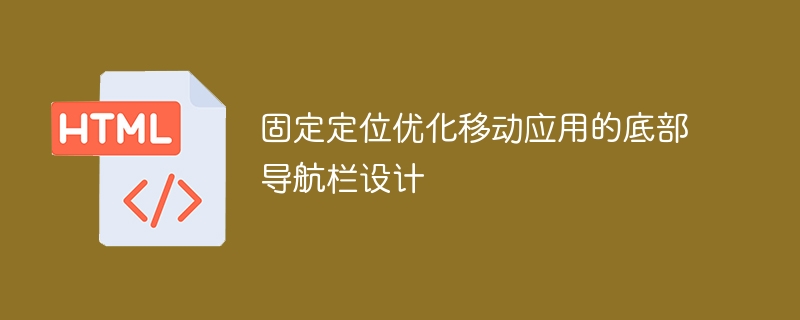

Fixed positioning optimization of the bottom navigation bar design of mobile applications requires specific code examples
With the popularity of smartphones and the rapid development of mobile applications, people are increasingly Mobile phones are used in many places for various activities, such as socializing, shopping, learning and entertainment. In order to facilitate user operation and navigation, mobile applications usually design a bottom navigation bar. However, the bottom navigation bar will appear differently on different screen sizes and devices, so we need to use a fixed positioning method to optimize the bottom navigation bar design to ensure consistency and user-friendliness on different devices.
Fixed positioning is a layout method that keeps the element stationary relative to the browser window by setting the positioning attribute of the element to fixed. In mobile applications, we can set the bottom navigation bar to fixed positioning so that it always stays at the bottom of the screen regardless of the user scrolling the page or performing other operations.
The following is a sample code based on HTML and CSS for implementing a fixed-positioned bottom navigation bar:
HTML code:
<!DOCTYPE html>
<html>
<head>
<meta charset="utf-8">
<meta name="viewport" content="width=device-width, initial-scale=1.0">
<title>底部导航栏</title>
<link rel="stylesheet" href="style.css">
</head>
<body>
<div class="container">
<h1>移动应用</h1>
<div class="content">
<!-- 页面内容 -->
</div>
<div class="footer">
<ul>
<li><a href="#">首页</a></li>
<li><a href="#">消息</a></li>
<li><a href="#">发现</a></li>
<li><a href="#">我的</a></li>
</ul>
</div>
</div>
</body>
</html>CSS code (style.css) :
body {
margin: 0;
padding: 0;
}
.container {
position: relative;
min-height: 100vh;
}
.content {
/* 设置页面内容样式 */
}
.footer {
position: fixed;
bottom: 0;
width: 100%;
height: 50px;
background-color: #f1f1f1;
}
.footer ul {
display: flex;
justify-content: space-around;
align-items: center;
height: 100%;
list-style: none;
}
.footer li a {
text-decoration: none;
color: #333;
}With the above code, we set the div element (class "footer") of the bottom navigation bar to fixed positioning and align its bottom with the bottom of the screen.
In CSS, we use position: fixed; to set the positioning attribute of the element to fixed positioning, and bottom: 0; to align the bottom of the element with the screen Bottom aligned. We also beautify the appearance of the bottom navigation bar by setting the corresponding height, width and background color.
At the same time, we use flex layout to align the link elements in the navigation bar horizontally and centrally, and use justify-content: space-around; to equally divide the link elements in the navigation bar middle.
In this way, no matter what operations the user performs on the page, the bottom navigation bar will always remain at the bottom of the screen, providing users with convenient navigation functions.
By optimizing the bottom navigation bar design of mobile apps with fixed positioning, we can ensure a consistent and user-friendly navigation experience across different screen sizes and devices. The sample code given above is available for reference and modification to help developers better design and implement the bottom navigation bar in mobile applications.
The above is the detailed content of Optimize the design of the bottom navigation bar to improve the fixed positioning function of mobile applications. For more information, please follow other related articles on the PHP Chinese website!




